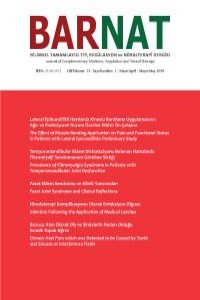Abstract
Temporomandibular joint dysfunction (TMD) is one of the major causes of non-dental pain in the orofacial region. Fibromyalgia
syndrome (FMS) is a chronic musculoskeletal disorder characterized by generalized pain, low pain threshold, sleep disturbance, fatigue,
psychological stress and tender points. Although the pain related with both of disorders has a similar etiology, diagnostic criteria
for FMS do not involve assessment of craniofacial region, and also in patients with TMD, the presence of FMS is often overlooked.
Therefore, in this study we aimed to investigate the incidence of FMS in patients with TMD. Twenty-five patients aged between 18-
41 were included in this study. It was noted that 60% of the patients had FMS and 73.3% of these had TMD with myogenic origin.
Inclusion of the orofacial area examination of the patients with FMS in the clinical diagnostic criteria may help to diagnose TMD in
the early period which may also positively affect the patients’ quality of life.
Keywords
Temporomandibular joint dysfunction fibromyalgia syndrome myofascial pain disc displacement
References
- 1. Auvenshine RC. Temporomandibular disorders: associated features. Dental clinics of North America 2007;51:105-127, vi. 2. McNeill C. Management of temporomandibular disorders: concepts and controversies. The Journal of prosthe c den stry 1997;77:510-522. 3. Moreno-Fernandez AM, Jimenez-Castellanos E, Iglesias-Linares A, Bueso- Madrid D, Fernandez-Rodriguez A, de Miguel M. Fibromyalgia syndrome and temporomandibular disorders with muscular pain. A review. Modern rheumatology 2017;27:210-216. 4. Huber MA, Hall EH. A comparison of the signs of temporomandibular joint dysfunc on and occlusal discrepancies in a symptom-free popula- on of men and women. Oral surgery, oral medicine, and oral pathology 1990;70:180-183. 5. Goldstein BH. Temporomandibular disorders: a review of current understanding. Oral surgery, oral medicine, oral pathology, oral radiology, and endodon cs 1999;88:379-385. 6. Suvinen TI, Reade PC, Kemppainen P, Kononen M, Dworkin SF. Review of ae ological concepts of temporomandibular pain disorders: towards a biopsycho social model for integra on of physical disorder factors with psychological and psychosocial illness impact factors. Eur opean journal of pain 2005;9:613-633. 7. Laskin DM, Greene CS, Hylander WL. Temporomandibular disorders: An evidence-based approach to dia gnosis and treatment. (1.Baskı). ABD: Quintessence Yayınevi, 219-228 8. Fujarra FJ, Kaziyama HH, Siqueira SR, Yeng LT, Camparis CM, Teixeira MJ, et al. Temporomandibular disorders in fi bromyalgia pa ents: are there diff erent pain onset? Ar quivos de neuro-psiquiatria 2016;74:195-200. 9. Nazlıkul H. Fibromiyalji Sendromu (FMS). Bilimsel
Abstract
Temporomandibular eklem disfonksiyonu (TMD), orofasiyal bölgede dental kaynaklı olmayan ağrıların başlıca sebebidir. Fibromiyalji
sendromu (FMS) ise generalize ağrı, düşük ağrı eşiği, uyku bozukluğu, yorgunluk, psikolojik stress ve hassas noktalarla karakterize
kronik bir kas-eklem sistemi rahatsızlığıdır. Her iki rahatsızlığa bağlı ağrılar benzer etiyolojiye sahip olmasına karşın FMS’nin tanı
kriterlerinde kraniyofasiyal alanın değerlendirilmesi yer almamakta ve TMD’si bulunan hastalarda da çoğu zaman FMS varlığı göz
ardı edilmektedir. Bu sebeple bu araştırmada, TMD’si bulunan hastalarda FMS’nin görülme sıklığının incelenmesi amaçlanmıştır.
Çalışmamıza yaşları 18-41 arasında değişen 25 hasta dahil edilmiştir. Çalışmaya dahil edilen hastaların %60’ında FMS’nin bulunduğu
ve bu hastaların da %73,3’ünün miyojenik kökenli TMD’ye sahip olduğu kaydedilmiştir. FMS’si bulunan hastaların orofasiyal alan
muayenesinin klinik pratikte kullanılan tanı kriterlerine dahil edilmesi, TMD’nin erken dönemde teşhis edilmesine yardımcı olabileceği
gibi hastaların yaşam kalitesini de olumlu yönde etkileyecektir.
Keywords
Temporomandibular eklem disfonksiyonu fibromiyalji sendromu miyofasiyal ağrı disk deplasmanı
References
- 1. Auvenshine RC. Temporomandibular disorders: associated features. Dental clinics of North America 2007;51:105-127, vi. 2. McNeill C. Management of temporomandibular disorders: concepts and controversies. The Journal of prosthe c den stry 1997;77:510-522. 3. Moreno-Fernandez AM, Jimenez-Castellanos E, Iglesias-Linares A, Bueso- Madrid D, Fernandez-Rodriguez A, de Miguel M. Fibromyalgia syndrome and temporomandibular disorders with muscular pain. A review. Modern rheumatology 2017;27:210-216. 4. Huber MA, Hall EH. A comparison of the signs of temporomandibular joint dysfunc on and occlusal discrepancies in a symptom-free popula- on of men and women. Oral surgery, oral medicine, and oral pathology 1990;70:180-183. 5. Goldstein BH. Temporomandibular disorders: a review of current understanding. Oral surgery, oral medicine, oral pathology, oral radiology, and endodon cs 1999;88:379-385. 6. Suvinen TI, Reade PC, Kemppainen P, Kononen M, Dworkin SF. Review of ae ological concepts of temporomandibular pain disorders: towards a biopsycho social model for integra on of physical disorder factors with psychological and psychosocial illness impact factors. Eur opean journal of pain 2005;9:613-633. 7. Laskin DM, Greene CS, Hylander WL. Temporomandibular disorders: An evidence-based approach to dia gnosis and treatment. (1.Baskı). ABD: Quintessence Yayınevi, 219-228 8. Fujarra FJ, Kaziyama HH, Siqueira SR, Yeng LT, Camparis CM, Teixeira MJ, et al. Temporomandibular disorders in fi bromyalgia pa ents: are there diff erent pain onset? Ar quivos de neuro-psiquiatria 2016;74:195-200. 9. Nazlıkul H. Fibromiyalji Sendromu (FMS). Bilimsel
Details
| Primary Language | Turkish |
|---|---|
| Journal Section | Research |
| Authors | |
| Publication Date | April 30, 2019 |
| Published in Issue | Year 2019 Volume: 13 Issue: 1 |


